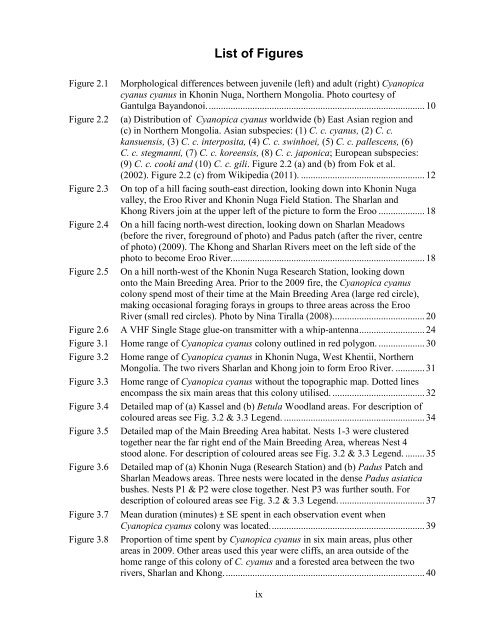Habitat use and population dynamics of the Azure-Winged Magpie ...
Habitat use and population dynamics of the Azure-Winged Magpie ...
Habitat use and population dynamics of the Azure-Winged Magpie ...
You also want an ePaper? Increase the reach of your titles
YUMPU automatically turns print PDFs into web optimized ePapers that Google loves.
List <strong>of</strong> Figures<br />
Figure 2.1 Morphological differences between juvenile (left) <strong>and</strong> adult (right) Cyanopica<br />
cyanus cyanus in Khonin Nuga, Nor<strong>the</strong>rn Mongolia. Photo courtesy <strong>of</strong><br />
Gantulga Bay<strong>and</strong>onoi. ......................................................................................... 10<br />
Figure 2.2 (a) Distribution <strong>of</strong> Cyanopica cyanus worldwide (b) East Asian region <strong>and</strong><br />
(c) in Nor<strong>the</strong>rn Mongolia. Asian subspecies: (1) C. c. cyanus, (2) C. c.<br />
kansuensis, (3) C. c. interposita, (4) C. c. swinhoei, (5) C. c. pallescens, (6)<br />
C. c. stegmanni, (7) C. c. koreensis, (8) C. c. japonica; European subspecies:<br />
(9) C. c. cooki <strong>and</strong> (10) C. c. gili. Figure 2.2 (a) <strong>and</strong> (b) from Fok et al.<br />
(2002). Figure 2.2 (c) from Wikipedia (2011). ................................................... 12<br />
Figure 2.3 On top <strong>of</strong> a hill facing south-east direction, looking down into Khonin Nuga<br />
valley, <strong>the</strong> Eroo River <strong>and</strong> Khonin Nuga Field Station. The Sharlan <strong>and</strong><br />
Khong Rivers join at <strong>the</strong> upper left <strong>of</strong> <strong>the</strong> picture to form <strong>the</strong> Eroo ................... 18<br />
Figure 2.4 On a hill facing north-west direction, looking down on Sharlan Meadows<br />
(before <strong>the</strong> river, foreground <strong>of</strong> photo) <strong>and</strong> Padus patch (after <strong>the</strong> river, centre<br />
<strong>of</strong> photo) (2009). The Khong <strong>and</strong> Sharlan Rivers meet on <strong>the</strong> left side <strong>of</strong> <strong>the</strong><br />
photo to become Eroo River. ............................................................................... 18<br />
Figure 2.5 On a hill north-west <strong>of</strong> <strong>the</strong> Khonin Nuga Research Station, looking down<br />
onto <strong>the</strong> Main Breeding Area. Prior to <strong>the</strong> 2009 fire, <strong>the</strong> Cyanopica cyanus<br />
colony spend most <strong>of</strong> <strong>the</strong>ir time at <strong>the</strong> Main Breeding Area (large red circle),<br />
making occasional foraging forays in groups to three areas across <strong>the</strong> Eroo<br />
River (small red circles). Photo by Nina Tiralla (2008). ..................................... 20<br />
Figure 2.6 A VHF Single Stage glue-on transmitter with a whip-antenna ........................... 24<br />
Figure 3.1 Home range <strong>of</strong> Cyanopica cyanus colony outlined in red polygon. ................... 30<br />
Figure 3.2 Home range <strong>of</strong> Cyanopica cyanus in Khonin Nuga, West Khentii, Nor<strong>the</strong>rn<br />
Mongolia. The two rivers Sharlan <strong>and</strong> Khong join to form Eroo River. ............ 31<br />
Figure 3.3 Home range <strong>of</strong> Cyanopica cyanus without <strong>the</strong> topographic map. Dotted lines<br />
encompass <strong>the</strong> six main areas that this colony utilised. ...................................... 32<br />
Figure 3.4 Detailed map <strong>of</strong> (a) Kassel <strong>and</strong> (b) Betula Woodl<strong>and</strong> areas. For description <strong>of</strong><br />
coloured areas see Fig. 3.2 & 3.3 Legend. .......................................................... 34<br />
Figure 3.5 Detailed map <strong>of</strong> <strong>the</strong> Main Breeding Area habitat. Nests 1-3 were clustered<br />
toge<strong>the</strong>r near <strong>the</strong> far right end <strong>of</strong> <strong>the</strong> Main Breeding Area, whereas Nest 4<br />
stood alone. For description <strong>of</strong> coloured areas see Fig. 3.2 & 3.3 Legend. ........ 35<br />
Figure 3.6 Detailed map <strong>of</strong> (a) Khonin Nuga (Research Station) <strong>and</strong> (b) Padus Patch <strong>and</strong><br />
Sharlan Meadows areas. Three nests were located in <strong>the</strong> dense Padus asiatica<br />
bushes. Nests P1 & P2 were close toge<strong>the</strong>r. Nest P3 was fur<strong>the</strong>r south. For<br />
description <strong>of</strong> coloured areas see Fig. 3.2 & 3.3 Legend. ................................... 37<br />
Figure 3.7 Mean duration (minutes) ± SE spent in each observation event when<br />
Cyanopica cyanus colony was located. ............................................................... 39<br />
Figure 3.8 Proportion <strong>of</strong> time spent by Cyanopica cyanus in six main areas, plus o<strong>the</strong>r<br />
areas in 2009. O<strong>the</strong>r areas <strong>use</strong>d this year were cliffs, an area outside <strong>of</strong> <strong>the</strong><br />
home range <strong>of</strong> this colony <strong>of</strong> C. cyanus <strong>and</strong> a forested area between <strong>the</strong> two<br />
rivers, Sharlan <strong>and</strong> Khong. .................................................................................. 40<br />
ix

















